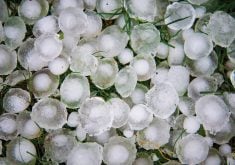A visit to an old grape orchard in the heart of B.C. wine country last summer has inspired two southern Alberta producers to try their hands at a different kind of viny crop — hops.
“That was really the seed that started it all,” said Randy Adams, who owns and operates Pair O’ Dice Hops with his brother-in-law Spencer Peterson.
“It immediately struck a chord as something that’s completely viable in Alberta — especially in southern Alberta with the climate and access to irrigation.
“And the more you read about it and talk to brewers, the more compelling the story becomes.”
The pair began their foray into hops — the buds of a vine-like plant that add flavour to beer — last fall when they planted a test plot of 100 plants on Peterson’s acreage near Vauxhall. Neither were farmers before planting those first test plants, but both come from fifth-generation farming families. With Peterson’s 20 years of agriculture experience and Adams’ business and marketing expertise, they figured they could make a go of it.
So far, they’re right.
“We’ve had pretty good success and fantastic feedback from local brewers,” said Adams.
“We went ahead this spring and planted an additional 1,000 hop plants on one acre. Things are going along pretty well.”

And that’s good news for the duo, who has invested $15,000 so far in getting the operation up and running. But they see the “massive opportunity” for local hops that has come with the recent boom in craft breweries across the province.
Right now, there are 59 small breweries operating in Alberta, with “at least that many more in the planning stages,” said Adams. Those breweries need more than 100,000 pounds of hops per year, and that number is “growing exponentially.”
“All of those brewers have to import their hops from Washington, Oregon, or Idaho, where the bulk of worldwide hop production is — but you lose any sort of semblance to local as soon as you go that far away,” said Adams.
Read Also

Farming Smarter receives financial boost from Alberta government for potato research
Farming Smarter near Lethbridge got a boost to its research equipment, thanks to the Alberta government’s increase in funding for research associations.
“All the brewers that we talk to have really identified with the idea of local, and a couple have made a firm commitment already to take our hops and want to partner with us in an ongoing way.”
And with a price premium that is 10 to 15 per cent above open market prices (last year’s average price in the U.S. was $5.72 a pound), producing for the craft brewery market is proving to be profitable for local hops growers.
“There are some advantages to buying local, as well as profitability for selling local.”
A costly venture
It’s a good thing too — the startup costs were “fairly significant” for the pair.
“To put an acre of hops in, just for the trellis and irrigation and plants, is roughly $15,000 an acre, which is only a small portion of the total capital requirements to be in the hops business,” said Adams.
A large part of the costs were the trellis system they had to install — a series of 38 telephone poles, each topping out at over 18 feet to accommodate the 18- to 20-foot vertical growth of the plants.
“They need something to climb on, so there’s a system of poles and cables above the hop yard trellis, and then we use heavy coconut twine from each of the cables down to each plant as the mechanism they use to climb,” said Adams.
The plants themselves are $5 to $15 per plant, depending on whether you purchase an established plant in a pot (which runs $10 to $15 per plant) or a root crown called a rhizome (around $5 a rhizome), which is what the pair did. Right now, the most popular hops varieties are Cascade and Centennial, which make up most of their planting, but they also have 11 other varieties — “some that are proven in our climate, some that are really experimental.”
“It’s a fairly significant part of the overall costs, but that $15,000 an acre would be inclusive of the plants to get started,” said Adams.
Hops will naturally propagate themselves, so after the initial startup costs for the plants, growers are able to grow their own. “Next year, we’ll be in a position to cut our own rhizomes from our own plants and then continue to expand our hop production.”
After planting, it’s roughly $1,500 an acre to fertilize the crops, as hops are “fairly nitrogen intensive.”
“We haven’t applied fertilizer this year, but next year and going forward, we’ll supplement with fertilizer based on soil test results,” he said.
Harvest and processing
Then it takes about three years for hops to “ramp up” to the plants’ full yield potential.
“A typical acre would produce about 1,200 to 1,500 pounds of dried hops. This year, we’re expecting somewhere in the area of 300 to 500 pounds of dried hops.”
There’s also “significant capital requirement” to purchase harvesting and drying equipment for the hops, and then to process and pelletize the hops into a format that the brewers can use.
“The $15,000 an acre to get started is just to start growing the plants,” said Adams. “It’s likely in the area of another $200,000 required to get basic harvest and processing capabilities in place.”
Harvesting by hand is a time-consuming and labour-intensive process, with a rate of one plant per person per hour.
“We’ve got roughly 1,100 plants, and 1,100 hours is just not viable,” said Adams. “Even at the smallest scales, you need some mechanization. This year, because the plants are still emerging and new, we expect that we’re going to build something homemade to strip the cones and leaves from the plants.
“By doing that, we expect we can improve that number to 10 plants per person per hour to bring our number of hours down.”
Down the road, the duo will be looking at commercial hop harvesters, which range from about $20,000 to $60,000. And once the hops are harvested, they have to be dried down to about eight to 10 per cent moisture and then pelletized so that they can be used by brewers.
“The vast majority of brewers will only use pelletized hops, but there are many who can use unpelletized hops, and for this year, that’s our primary market,” said Adams.
“We were going to experiment with pelletizing this year, but there’s likely a large capital investment that’s required to get all of the components in place. That will be a next-year project for our full production.”
Growth potential
But even with all the upfront costs, the pair believes they’ll recoup their initial investment by next year.
“As we work on our business plan for the full complement of harvesting and processing equipment, we think that if we’re doing 10 acres, within two years we can hit a break-even point and we’ll be cash positive beyond the second year.”
The first year has really been a “proof of concept” to make sure that the crop is viable in Alberta and that the market demand is there.
And so far, their first growing season is bearing both those things out.
“The crop is completely viable here — there’s growers as far north as Edmonton producing crops that are equal in quality and yield as what we’re seeing out of the United States,” said Adams.
“From a market growth perspective, there’s been tremendously positive feedback from brewers. With 59 brewers today, we probably can’t supply all of the hops for one brewery.”
That means there’s plenty of room to grow Alberta’s hops production. In February, Adams and Peterson formed the Alberta Hop Producers Association, and so far, the association has about nine members — all but one in their first production season and none larger than one acre. But with another dozen producers expressing interest, the local hops industry is “coming along.”
“People see the boom in the Alberta beer market, and they’re looking for opportunities to get involved,” said Adams.
“I suspect most will be scared off by the capital costs, but those who can see through that will see there’s a great opportunity here.”















